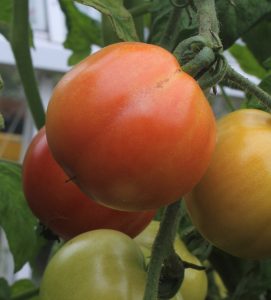There are two important jobs for the greenhouse at this time of year. From February onwards, it’s time to sprout (or ‘chit’) first and second early potatoes and sowing tender, long season crops like tomatoes.
Gardeners’ ‘chit’ potatoes so they are already growing when planted, – it’s a chance to get ahead. The technique is simple. Put your potatoes in a tray or egg box with the ‘rose’ end, (where there is the greatest cluster of buds or ‘eyes) at the top. After around four or five weeks in the greenhouse at about 7C (45F), the shoots should be about 5cm (2”) long and the potatoes will be ready for planting. The shoots can be longer, just make sure there is enough light and not too much heat so they don’t become ‘leggy’ and break off. It’s important to get your timing right, so that they are ready for plant just after the last frosts in your area and the soil has warmed. Adjust your ‘chitting’ time according to where your location; starting later in cold spots or in the north. As a precaution, keep a few sheets of newspaper or horticultural fleece on standby, listen to the weather forecast and cover young shoots in the cold greenhouse if sudden late frosts are forecast.

Plants like peppers, chillies and aubergines needing up to five months to mature should be sown this month. Most gardeners who complain that their peppers and aubergines haven’t ripened, simply sowed their seed too late – though a sunny summer and feeding with tomato fertiliser helps greatly. Sowing tomatoes in third week in February is ideal, mid-March is fine and the first week in April is the limit. If you are unable to provide light, warmth and constant temperatures for germination. If your greenhouse is unheated, sow later or buy young plants from the garden centre or from the internet later in the year.
Warm a seed tray, 10cm pot or modules of peat free seed compost in the greenhouse for 24 hours before sowing – the propagator is ideal. Water with a fine rose, using tepid water and leave it to drain for at least half an hour. Sow the seeds over the surface, six to a pot or two or three per module, then sprinkle a shallow layer of fine grade vermiculite over them. Pop them in a propagator 18-21C (64 -70F) and they will take about three weeks to germinate. Thin to leave the strongest seedling, then transplant when they are large enough to handle, lifting the seedlings gently by a leaf, into a 9cm pot and grow on in the greenhouse at 10-15C. Make sure that there is enough space between the pots so the seedlings don’t become elongated searching for the light. Once the pots are well rooted (but not ‘pot bound’) move them into their final growing position in a heated greenhouse in 25cm pots, growing bags or the greenhouse border. ‘Harden off’ outdoor tomatoes, then plant once the danger of frost has passed.
Happy Gardening. Matt


